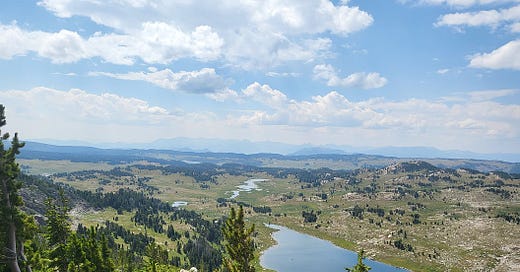Who is wilderness solitude for?
In Part 2 of the Solitude Trilogy, we look at how wilderness and solitude got tied together
Last week, I told a story of failing at wilderness solitude. This week, I dig into why that happened.
In 1964, America tried to give wilderness a legal definition. This may have been a foolish quest, because wilderness is a term of romance and spirituality, a term that expresses ultimate forms of a natural world that is by definition bigger and more profound than any legal construct. But it was a valiant and worthwhile quest, because if you’re going to try to preserve wilderness, you have to say what it is.
The 1964 Wilderness Act is rightly lauded for its poetry and concision. Its paragraph-long definition of wilderness contains much-quoted wisdom, including the idea that these are lands “untrammeled by man.” Several phrases enhance that idea, including “retaining its primeval character,” “without permanent improvements or human habitation,” and “with the imprint of man’s work substantially unnoticeable.” But furthermore, the Act defines wilderness as having “outstanding opportunities for solitude or a primitive and unconfined type of recreation.”
Scholars Jesse Engebretson and Troy Hall have done exhaustive analysis of the solitude phrase. Arguing that primitive and unconfined recreation is a separate thread, they boil solitude down to two factors:
A “sensory escape from the city”: getting away from the noise and stench and stress of 20th century urban life.
A sense of the overwhelming power of nature that you get as a tiny creature in a vast undeveloped landscape; a feeling of remoteness and (if I might use a word from a previous era) the sublime.
I like this analysis. I achieve both of these feelings when I’m in official wilderness areas, and I get fulfillment out of these feelings. I’m grateful to the 1964 Act and the folks who work every day to preserve its solitude. I hope these opportunities never go away.
At the same time, I’m aware that wilderness is not very trendy right now in the general population. Under attacks from both the political right (seeking more development) and left (seeking more equity and justice), wilderness defenders struggle to rally support. And I wonder if one reason people don’t care so much about wilderness is that they don’t care so much about wilderness solitude.
Consider: urban life is not as noisy and stinky as it was in 1964 (and the decades building up to that climax). Our homes and cars are better insulated and isolated. Our economic base is moving from industry to services. There’s less to get away from, geographically.
The stress is certainly worse. But how to get away from it? In a fast-paced world, it’s harder to schedule a multi-week wilderness getaway. The benefits of solitude evaporate much more quickly when several hundred emails await you the next Monday morning. And with technological advances, “the city” you’re trying to escape ends up going with you in your pocket.
Consider: the 1950s were a high-water mark for American religious expression. More people went to church then than at any point before or since. They were thus eager to find God in nature, to feel themselves insignificant in the face of vast forces. Today, such thinking is far less popular.
Consider: the Act didn’t define wilderness solitude as aloneness. But, perhaps as these other factors diminished, aloneness has come to the fore. I noted last week that this may be tied to our culture’s individualist mythology. Maybe it’s also tied to misanthropy.
Do you go to the wilderness to get away from people? Then wilderness solitude—as it’s commonly viewed today—is for you. But if this is your motivation, you need to understand that you have departed from the traditional definition of wilderness solitude. This is not what the 1964 law intended, not what society agreed to.
Wilderness solitude was originally about sensory overload and spirituality—and roads. The Wilderness Society, which spearheaded the campaign for the 1964 Act, had been founded in response to massive public-land road-building in the 1930s. Its leaders wanted to preserve stretches of roadless landscape because roadlessness was key to the capacity for primitive and unconfined recreation. For spirituality. For ecology (though in the 1930s the discipline was still rather primitive). And for their ideas of solitude, which frequently included the presence of other people.
There’s nothing immoral about seeking wilderness solitude as the opposite of people. It’s just really hard to achieve on a practical level, especially if you want it paired with scenery, ecological richness, and convenience. When the pretty spots get crowded, we sometimes see it as a failure of wilderness. Instead, it’s a failure of our wilderness solitude ideal. If an ideal is inherently unachievable, then political struggle will be neverending.
Finally, consider (here’s your teaser for next week): As a provider of solitude, wilderness faces tough competition.





Waiting for next week. But being human, opportunities for solitude in wild places are vital to our mental and physical health. One reason the world is such a mess is because such experiences are either not available to millions (billions?) or they've been displaced from lives by various opiates of the masses.
Part 3 is here: https://naturalstories.substack.com/p/the-end-of-wilderness-solitude